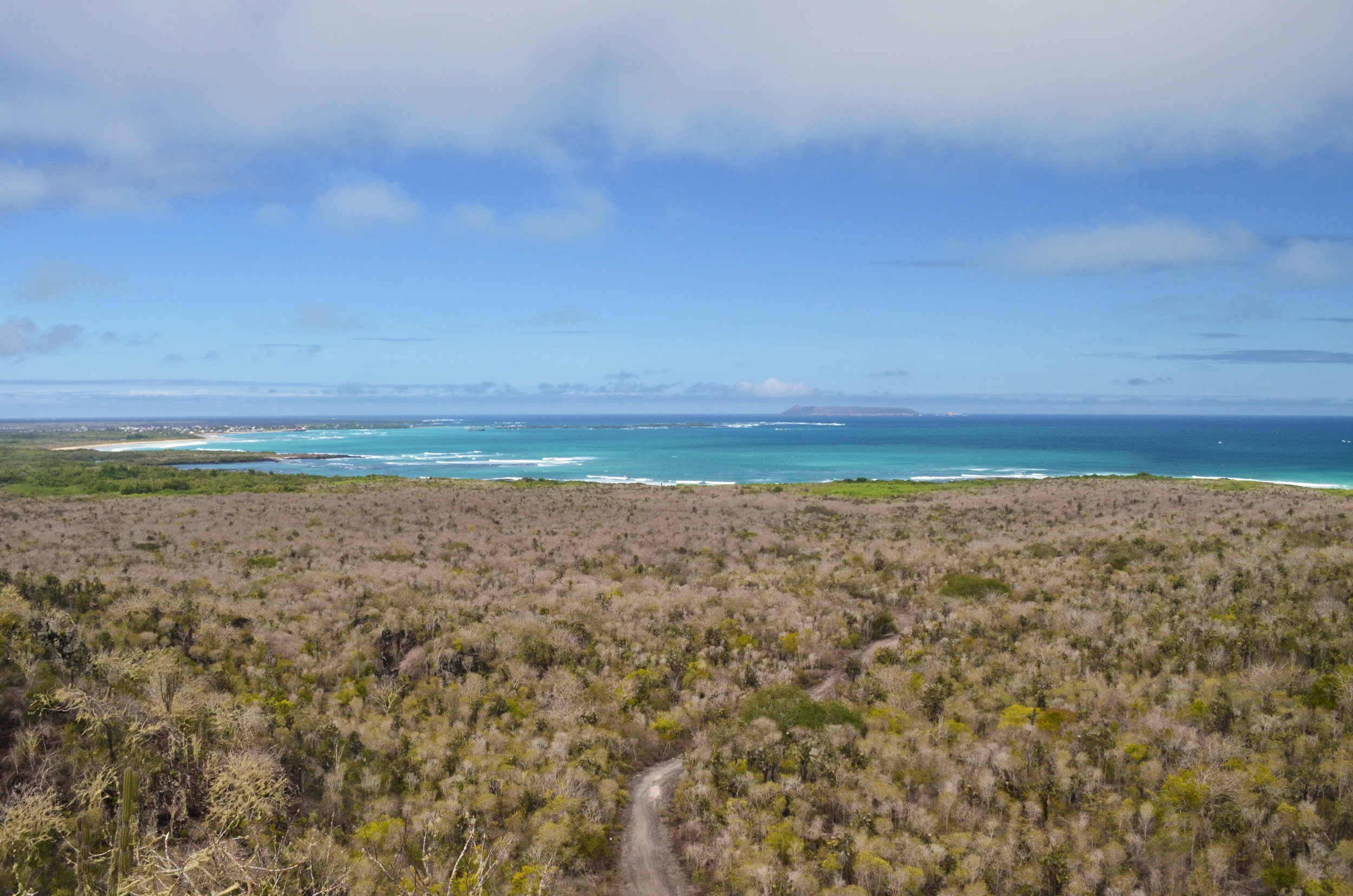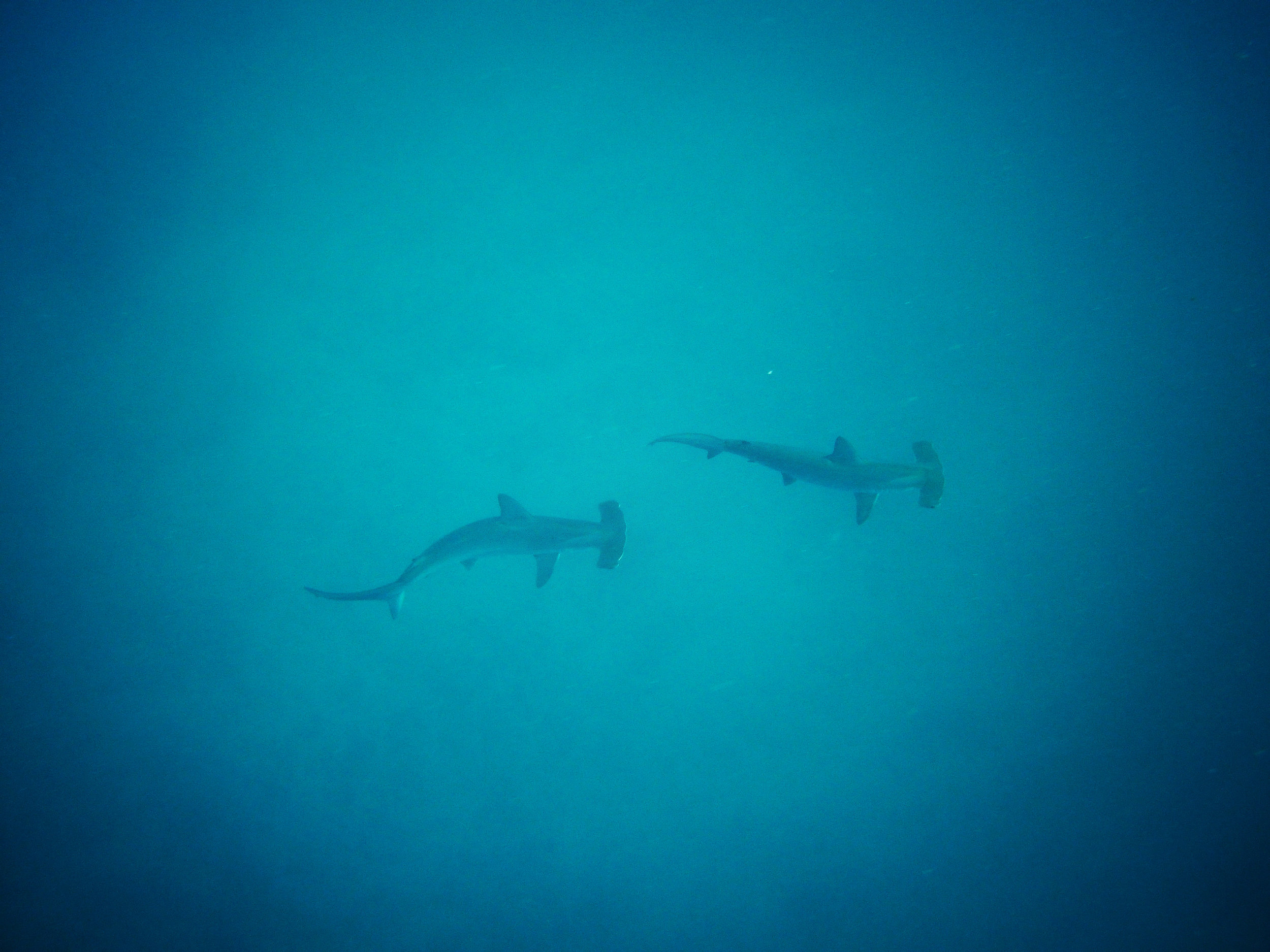Where the wild things are: Our best holiday in the Galapagos
It wasn’t part of our original plan. An archipelago nearly 600 miles off the coast of Ecuador, the Galapagos Islands were a remote destination that we’d planned to visit one day on a trip of its own. But as we meandered our way down Central and South America and approached the equator, the magnetic pull of this legendary destination captured us. We couldn’t resist. We were going to the Galapagos.
The lookout point over Tijeretas on San Cristóbal Island, with Kicker Rock on the horizon
The impulse decision to buy plane tickets only eight days in advance had us giddy. Since we hadn’t planned on visiting the islands, we had no idea or expectation of what awaited us — only dreams of a close encounter with sea lions or giant tortoises. Luckily, we could afford to spend seventeen days exploring three of the inhabited islands and the ocean they were birthed from — hopefully enough time to run into the many unique species that call these islands home.
A marine iguana basks in the sun on Isabela Island
When we landed on the tarmac at Baltra airport, the warm breeze and alien landscape greeted us. Strange cacti sprouted from the cracked earth. The rich clay colors of the landscape competed for attention against the cyan water. After stepping off the runway, we were shepherded into the airport where we paid the park entrance fee and rangers inspected luggage for foreign plants and seeds. The protected islands face a persistent threat of invasive species, and park rangers continually battle non-endemic plants and animals.
The arid landscape of Isabela Island
Before arriving, we had made a list of all the creatures we hoped to encounter along with notes about which islands held the most promise for sightings. What we didn’t expect was to live among so many sea lions, marine iguanas, and frigate birds in our daily existence. During our many months of traveling through Latin America, we had become accustomed to roaming street dogs and even the occasional cat caravan, but the Galapagos is a magical place where far more exotic creatures go about their day alongside humans. Marine iguanas bask on the sidewalks, and sea lions bark for their favorite cuts from the fishermen at the wharf. Humans and animals live in harmony with one another. As we explored our first town, Puerto Ayora on the island of Santa Cruz, park rangers peacefully stood watch at the pier and on beaches to make sure the animals were safe. We were glad to see a general respect for the wildlife from all the humans — locals and tourists alike.
A sea lion scopes out the catch of the day at the fish market on Santa Cruz Island
A giant tortoise is caught crossing the trail
A sea lion pup lounges on the steps at Concha la Perla
Sally lightfoot crabs cling to volcanic rock as waves crash over them on San Cristóbal Island
A blue-footed booby cares for her eggs on Isabela Island
A sleepy sea lion pup naps with mama on the dock
To encounter even more of the wildlife, we’d need to suit up and take a dive in the Pacific. The mingling of ocean currents around the archipelago creates some of the most nutrient-dense waters on Earth, making it one of the most diverse marine ecosystems in the world. Species that exist nowhere else thrive here. Because the islands and surrounding waters are protected, animals like the humpback whale and the scalloped hammerhead shark mate and breed here. With no natural predators (though illegal fishing vessels continue to pose a serious threat), they find refuge and plenty of food in the Galapagos, helping boost their population numbers. This means not only healthier marine ecosystems, but an increased chance to spot some of these majestic creatures.
Nutrient-rich waters surround the islands
Collapsed lava tunnels form a maze through turquoise waters on Isabela Island
Despite the cold water, we couldn’t keep ourselves out of it. Day after day, we’d put on our masks and snorkel with dozens of green sea turtles, golden rays, and white tip sharks. Playful sea lion pups darted around us like torpedos, much more graceful underwater than their awkward hobble on land. They tugged on our flippers and came right up to our noses, drawn to the bubbles divers make when exhaling. The underwater world was as curious about us as we were about it.
A great dive off Kicker Rock
We had obtained our open water diving certification earlier in the year, and now we were being spoiled with the chance to dive in the Galapagos, a territory filled with famous sites that seasoned divers from all over the world come to visit. We’d seen stunning coral off the coast of Colombia and colorful fish in the Caribbean, but the Pacific was something entirely new. The water was frigid, and the currents were strong. Here, we were on the lookout for marine life bigger than us.
During the ride out to our first dive site, our guide Oscar briefed us on the rules of diving in the national park: if any diver intentionally touched an animal, we would all be forced to surface immediately and return to shore. It seemed harsh, but it made sense. If the Galapagos is to continue to be a sanctuary where we can experience wildlife so closely, the protection of animals from human harm must be a priority. As we were in one of the most marvelous marine ecosystems in the world, Oscar then asked what each of us hoped to see during our submersion. “Sea turtles!” “Rays!” “Sea lions!” one person said after another. An Aussie wanted something even more spectacular: an orca whale. Oscar and the other guides quickly tried to lower his expectations. Whales are a rare sighting, even here. As we reviewed dive signals for each animal, we ended with our fists bunched up on each side of our heads. None of us wanted to jinx our luck, but secretly we all wished to see one of the most famous inhabitants in these waters: hammerheads.
A green sea turtle leads a group of snorkelers through Los Tuneles off Isabela Island
A school of yellowtail grunts and a lone parrotfish
Golden rays swim along the floor of Los Tuneles off Isabela Island
As we descended into the marine landscape, sea turtles and dozens of blacktip sharks swam by us. The floor was covered in sea stars bigger than our heads. Rays gracefully floated underneath us. As our eyes darted in every direction, Oscar grabbed our attention. We were hovering above a pair of hammerhead sharks. Their muscular bodies pulsed back and forth, propelling them through the abyss. In seconds, they were gone. We luckily spotted six more on our dive.
Two scalloped hammerhead sharks swim around North Seymour off Santa Cruz Island
Overcome by the awe of seeing these ancient predators in their habitat, we were reluctant to surface. It was our most challenging but most rewarding dive yet, and we didn’t want to go back to shore. We thought the day couldn’t deliver more, but we were so wrong. As we inflated our buoyancy devices and floated at the surface, we signaled for the boat to pick us up. Just then, we noticed an uproar of splashing no more than 100 meters away. Frigate birds were circling the area, and we knew something large was feeding. Suddenly, a giant black fin emerged from the water. Shortly after, we saw another one breach. A pod of orcas was hunting right in front of us! Even though we could now speak above water, there were no words. We held hands underwater, squealed, and even cried a bit. We felt so tiny next to these giants. Back on the boat, Oscar smiled at the Aussie and said, “I guess it was your lucky day.”
Experiencing wildlife so close and so free was one of the happiest moments of our lives. There is a palpable serenity seeing these animals live without fear of humans. It was a glimpse of a paradise we envision, of people and nature living in a state of mutual respect and harmony. As we explored the museums and learned more about the fascinating history of these islands, we couldn’t help but realize this little slice of paradise exists only because people have dedicated their efforts to preserving this environment. The Galapagos is as much an ecosystem of humans as it is a wildlife preserve. And to ensure the continuation of this conservation project, we as tourists must tread as gently as possible. Supporting the people who call this land home — the people who care most about protecting it — will ensure these extraordinary places are around for generations to come. We departed the islands not only with a deepened sense of wonder and appreciation for the miracles of evolution, but also a feeling of gratitude for those who have worked tirelessly to protect and conserve this natural sanctuary. The Galapagos Islands are a testament to what humans can do when we value stewardship rather than dominion over the environment.
Maybe we’ll win a chance to see more wildlife…
We’ve written this post as an entry to win a luxury safari in Tanzania with Yellow Zebra Safaris. When we came across the competition announcement, we were giddy at the opportunity to see a part of the world we’ve always dreamed of visiting with a company that shares our values of investing in local communities and conservation.
Years ago we visited Central America, and our love of Latin America was born. Eventually this one trip would lead us to take a year and a half long journey trekking from Mexico to Patagonia. Neither of us has ever been to Africa, and we suspect a once-in-a-lifetime safari in the Northern Circuit would be the beginning of a lifelong love affair with another diverse, complex, and beautiful continent.
















